Budapest Ferenc Liszt International Airport
| Budapest Ferenc Liszt International Airport Budapest Liszt Ferenc Nemzetközi Repülőtér | |||||||||||||||
|---|---|---|---|---|---|---|---|---|---|---|---|---|---|---|---|
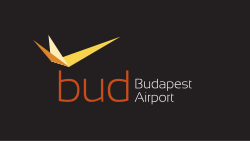 | |||||||||||||||
|
| |||||||||||||||
| IATA: BUD – ICAO: LHBP | |||||||||||||||
| Summary | |||||||||||||||
| Airport type | Public | ||||||||||||||
| Owner | Budapest Airport Ltd.[1] | ||||||||||||||
| Operator | Budapest Airport Ltd.[2] | ||||||||||||||
| Serves | Budapest, Hungary | ||||||||||||||
| Location | 16 km (9.9 mi) south-east of centre of Budapest | ||||||||||||||
| Focus city for | |||||||||||||||
| Elevation AMSL | 151 m / 495 ft | ||||||||||||||
| Coordinates | 47°26′22″N 019°15′43″E / 47.43944°N 19.26194°ECoordinates: 47°26′22″N 019°15′43″E / 47.43944°N 19.26194°E | ||||||||||||||
| Website |
www | ||||||||||||||
| Map | |||||||||||||||
 BUD | |||||||||||||||
| Runways | |||||||||||||||
| |||||||||||||||
| Statistics (2015) | |||||||||||||||
| |||||||||||||||
Budapest Ferenc Liszt International Airport[5] (Hungarian: Budapest Liszt Ferenc Nemzetközi Repülőtér) (IATA: BUD, ICAO: LHBP), formerly known as Budapest Ferihegy International Airport and still commonly called just Ferihegy, is the international airport serving the Hungarian capital city of Budapest, and by far the largest of the country's four commercial airports. The airport is located 16 kilometres (9.9 mi) east-southeast of the centre of Budapest and was renamed in honor of the most famous Hungarian composer Franz Liszt (Hungarian Liszt Ferenc) on the occasion of the 200th anniversary of his birth.
It offers international connections primarily within Europe, but also to Africa, the Middle East, the Far East. From June 2015, the transatlantic flights were restored with two carriers flying to Toronto and Montreal. In 2012, the airport handled 8.5 million passengers and experienced a significant drop in aircraft movements and handled cargo, primarily due to the collapse of Malév Hungarian Airlines earlier in the year, hence losing a large portion of connecting passengers. It was the hub for Malév until the airline's bankruptcy on 3 February 2012, when at 6 am Malév ceased its operations after almost 66 years of service.[6] Before its closure, the airline had more than one third of the air traffic at the airport,[7] and about 40% of the revenues at Budapest airport originated from Malév operations.[8] The airport serves as a base for Ryanair and Wizz Air, and served 9,155,961 passengers in 2014, a 7.5% increase over 2013.[9]
Name
Originally called Budapest Ferihegy International Airport (Budapest Ferihegy Nemzetközi Repülőtér), on 25 March 2011 it was officially renamed Budapest Ferenc Liszt International Airport, in honor of the Hungarian pianist and composer Franz Liszt (Modern Hungarian: Liszt Ferenc.) Popularly, the airport is still called Ferihegy as before.
Ferihegy is the name of the neighbourhood around the airport. The name is derived from that of Ferenc Xavér Mayerffy (1776–1845), the former owner of an estate who established vineyards and contributed to the development of viticulture in Pest-Buda. "Feri" is a diminutive form of Ferenc while "hegy" means hill. In fact the area is almost totally flat but originally there was a 147 m high sandy hillock which was levelled in the 1940s during the constructions works of the airport.
History
Designing and construction (1939–1944)
In 1938 the idea of building a new airport in Budapest was born. The area in the boundary of three settlements (Pestszentlőrinc, Rákoshegy and Vecsés) was assigned as the area of the new airport. The airport was intended as jointly for civil-military-sporting purposes. Civil facilities were to be built up in the north-western and military ones in the south-western section. Just as for each building, a public tender was invited for the designing and construction of the traffic building.
In December 1939, upon announcement of the results of the tender invited in September that year, the designs of Károly Dávid Jr. (1903–1973) were chosen. The designer, who was one of the originators of modern Hungarian architectural art, dreamt of a building which resembled an aircraft from the top-side view. The work commenced in 1942. To approach the airport from the city, a 16-kilometre (10 mi) high-speed road was constructed between 1940 and 1943, which, after improvements, remains in use today.
The military buildings were constructed parallel to the civil construction from 1940 but, due to the war situation, faster. Aviation started at the airport in 1943. In wartime, the civil construction slowed down and then stopped at the beginning of 1944. Towards the end of World War II, many of the airport buildings were damaged. By the end 1944, Budapest and its airport were under Soviet occupation.
Reconstruction (1947–1950)
In 1947 it was decided that the airport would be reconstructed for civil aviation. Under the three-year plan 40 million forints were voted for those works. The opening ceremony was held in May 1950 and the sections finished allowed Magyar-Szovjet Polgári Légiforgalmi Rt. (Hungarian-Soviet Civil Aviation Co. Ltd. – MASZOVLET), established in 1946, to operate here. At that time the airlines operated only a few foreign flights, in particular those to Prague, Bucharest, Warsaw and Sofia.
Magyar Légiforgalmi Vállalat (Hungarian Airlines – Malév) was established on 25 November 1954. The first regular flight taking off from the airport to the West was the Malév's flight into Vienna in summer 1956. The first Western airline which launched a flight to Budapest was KLM Royal Dutch Airlines in 1957. The traffic building was finished in this period and the lengthening works of the 2,500-metre (8,202 ft) runway were started. At the end of 1958 the runway was lengthened to 3,010 metres (9,875 ft) and taxiway D was finished.
Continued growth (1960–1980)
Between its opening and 1960, the number of landings at the Airport increased from 4,786 to 17,133, with passenger traffic increasing from 49,955 to 359,338 by 1960.
In 1965, a study was made on the development of the airport, which was implemented with more than a 10-year delay from the end of the 1970s. Aviation, airport, and flight control all called for more capacity and infrastructure. The Aviation and Airport Directorate (LRI) was established on 1 January 1973 and performed as an airline company, a trade company, and an authority, as well as investment, operator, and air navigation tasks.
In 1974, passenger traffic reached one million. In 1977, a new control tower was built, as well as a second runway parallel to the old one and a technical base for maintaining MALÉV aircraft. Use of the new 3,707-metre (12,162 ft) runway was started in September 1983.
New infrastructure (1980–2000)
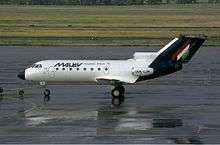
In 1980, the number of landing aircraft and passengers served reached 32,642 and 1,780,000, respectively. The growing number of passengers called for more capacity. A new terminal was decided upon. The foundation-stone of the new passenger traffic building to be built was laid down on 16 November 1983. Since 1 November 1985, passengers have been received in Terminal 2, a 24,000-square-meter facility funded with Austrian loans under general contracting. It was used first by Malév aircraft and passengers, and then by those of Lufthansa, Air France, and Swissair. The old terminal continued to receive residual airline traffic under a new name, Terminal 1.
In 1990, more than 40,000 take-offs and landings were registered and 2.5 million passengers were served.
There was an IED bus attack against Russian Jewish emigrants on the road leading to Ferihegy in the early 1990s. The perpetrators were members of the German Communist organisation Red Army Faction.[10]
In 1993, Malév launched the airport's first Hungarian overseas flight, to New York. According to the traffic figures forecast for the millennium, the two terminals serving 4 million passengers a year promised to be insufficient. The construction of Terminal 2B was started in 1997. The new building, with more than 30,000 square meters of space, together with a new apron, was opened in 1998, with all foreign airlines moving there. Terminal 2B can receive 3.5 million passengers a year, with its seven gates and five remote stands.
Public to public-private ownership (2000–2012)
In January 2002, in lieu of the liquidated Aviation and Airport Directorate, two new organisations were established. HungaroControl became responsible for air navigation and Budapest Airport Zrt. for operation of the airport. Between 1998 and 2005, passenger figures at Budapest Airport doubled – from 3.9 million to 7.9 million and major investments were called for.
This time, the Hungarian State, sole owner of the airport, opted for a partial privatisation with the integration of a private strategic partner with international experience. In June 2005, the State's privatisation agency initiated a tender for a concession. Seventy five percent minus one vote of Budapest Airport Zrt.'s shares were to be given to new private owners. The tender was finalised by the end of the year and the British company BAA, owner and operator of the major British airports, took over the management of the airport company.
On 8 December 2005, a 75% stake in Ferihegy Airport was bought by BAA plc for 464.5 billion HUF (approx. 2.1 billion USD), including the right of operation for 75 years.[1] On 20 October 2006, BAA announced intentions to sell its stake in Budapest Airport to a consortium led by the German airports group, HOCHTIEF AirPort GmbH, subject to the consent of the Hungarian State.
On 18 April 2007, the renovation of Terminal 1 at Ferihegy was awarded Europe's most prestigious heritage preservation prize, the Europa Nostra award. The designers, contractors, builders and investors (the latter being BA) received the joint award of the European Commission and of the pan-European heritage preservation organisation Europa Nostra for the renovation of the protected monument spaces, the central hall, the gallery and the furniture at T1.
One and half years later, in June 2007, there was a change in the management when the new owner of BAA decided to dispose of its shares and sell them to the German company HOCHTIEF AirPort and three financial partners.
On 6 June 2007, BAA and a consortium led by HOCHTIEF AirPort (HTA) formally closed and completed the transaction of the sale of BAA's shares in Budapest Airport (BA) to the HOCHTIEF AirPort Consortium. The ownership of the HOCHTIEF AirPort Consortium was as follows: HOCHTIEF AirPort (49.666%) and three financial investors: Caisse de dépôt et placement du Québec, Montreal (23.167%), GIC Special Investments, Singapore (23.167%) and KfW IPEX-Bank, Frankfurt (4.0%).[11]
On 26 July 2010, after completing a security oversight investigation in May,[12] the EU authorities revoked Budapest Airport's official "Schengen Clear" certification, due to serious lapses observed in personal security check procedures and unauthorised passing of banned objects. This meant passenger connecting via another airport in the Schengen Zone would have to be rescreened through security, just as foreign non-Schengen connecting passengers, causing delays and inconvieniance. The airport argued that it had not yet had time to fully implement new security measures introduced on 29 April 2010, and inspired by the Delta Air Lines' Amsterdam "underwear bomb scare" incident. The airports layout was also cited as an excuse for the failure. Budapest Airport was the first airport to be checked through a stringent undercover evaluation for compliance with the new regulation. (Hungarian state news agency MTI reports: ) In response additional security measures were immediately implemented at Budapest Airport causing flight delays at both terminals. Unusually long passenger waiting queues were observed at the more busy 2A-B terminal complex's departures area. These problems were solved over time, especially through the opening of the SkyCourt terminal including a central security zone.
On 15 November 2010, Budapest Airport regained the "Schengen Clear"-status, after implementing the necessary security actions and after that the airport underwent the strict re-inspection.[13]
On 16 March 2011, the name of Budapest Ferihegy International Airport was changed to Budapest Ferenc Liszt International Airport.[2]
Sky Court, the new expansion project including shops, restaurants and lounges, also connecting Terminals 2A and 2B was opened on 27 March 2011. In summer that year, the refurbishing of the old terminal parts in T2 began and was completed in 2012.[14]
Collapse of Malév and aftermath (2012–)
In the wake of the collapse of Malév, Ryanair announced that it would expand its flights to Liszt airport. Ryanair began selling the flight tickets to the public, but Budapest airport said that the company had not secured all of the necessary slots (which was later negotiated successfully).[15] By 9 February 2012, only six days after the collapse of the Hungarian national carrier, Liszt Ferenc Airport had recovered over 60% of its point to point traffic. Airlines that announced that new services would begin included Wizz Air, Aegean Airlines, Air Berlin, Lufthansa, and Ryanair.
However the airport had lost Malév's transfer passengers, which, prior to the airline's collapse, had amounted to 1.5 million passengers per year. A second effect of the Malév collapse was that the areas used to service the Malév fleet would no longer generate revenue even once point to point traffic had been restored. These factors created significant financial shortfalls in the airport's revenues.[16]
In February 2012 Hainan Airlines announced that they would cease services to Beijing from Budapest.[17] Prior to the collapse of Malév, Hainan had a partnership with Malév,[18] which included a codeshare.[19]
In May 2013 Hochtief Group announced the sale of its Airports unit HOCHTIEF AirPort which held a stake in the Budapest Airport and other airports to the Canadian Pension fund Public Sector Pension Investment Board (PSP Investments).[20] Following the sale HOCHTIEF AirPort was renamed to AviAlliance.[21]
As of July 2015, the ownership of the Budapest Airport is as follows: AviAlliance (52.666%) owned by PSP Investments, Canada, Malton Investment (22.167%) owned by GIC Special Investments, Singapore, Caisse de depôt et placemen de Québec, Canada (20.167%) and KfW IPEX-Bank, Germany (5%).[22]
Future developments
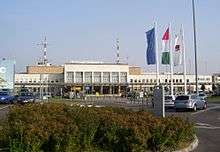
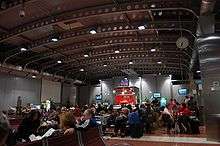
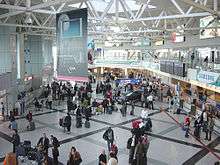
An expenditure of 261 million euros was spent in order to expanding and modernising the airports infrastructure until December 2012. Several of these future projects involve about further 300 million euros, and depends on regulatory decisions as well as third-party investors.[23] Among the finished and the further planned projects are:
- Finished projects
- Internal and external refurbishment of Terminal 2A and 2B (done as of 27 March 2011)
- Construction of the SkyCourt (done as of summer 2012)
- Apron development (done as of 27 March 2011)
- Development of a business area (first building for DHL opened on 13 August 2013)[24][25]
- Planned projects[26]
- Car park extension (late 2016)
- New cross docking facility for DHL (late 2016)
- New Airport Hotel (spring 2017)
- New pier for Terminal 2B (2018)
- New Terminal 2C (2020)
Terminals
Ferihegy airport has three main terminals: 1, 2A and 2B, and a smaller one for general aviation flights. A new air cargo base is to be built. Transfer between terminals 2A and 2B can be made on foot. The older Terminal 1, however, is located further away (i.e. closer to the city of Budapest) and must be reached by bus. From the city center, Terminal 1 can be reached by MÁV train directly and Terminal 2 is served by BKK bus.
On 30 March 2008, all Hungarian airports joined the Schengen Agreement and all Schengen flights moved to Terminal 2A, while non-Schengen flights moved to 2B. Terminal 1's low cost carriers were also separated by a glass wall into Schengen and non-Schengen traffic.
Terminal 1 (closed)
From 1 September 2005, re-opened Terminal 1 served low-cost carriers. Terminal 1 is divided into Schengen and Non-Schengen boarding gates.[27]
The terminal was totally renovated in full compliance with the requirements of historical monument protection, since the building is one of the finest examples of architectural modernism, built from 1939 (and interrupted by the war, then finished in 1950). The Terminal 1 is unusual in that it resembles the shape of an aircraft, when viewed from above, and is unique in style across Europe. For these reasons, the reconstruction received the Medal of the Europa Nostra Award.[28][29]
Terminal 1 is unusual among low-cost airline destinations, being located within the premises of Budapest and offering faster public transport time to the city center, compared to the Terminal 2 about 7 kilometers farther. (Terminal 1 offers an about 20 minutes direct train journey to Budapest city centre, while Terminal 2 requires an 8-minute bus ride to the train station).[30]
Building 18/A of the Terminal 1 compound houses the head office of the Transportation Safety Bureau of Hungary (TSB).[31] The Directorate for Air Transport of the National Transport Authority (NKH), which governs commercial aviation in Hungary, has its head office inside Building 13 at the Terminal 1 compound.[32] The head office of the predecessor agency of the TSB, the Civil Aviation Safety Bureau, was in Building 13.[33] In addition Civil Aviation Authority, the predecessor of the NKH, also had its head office in Building 13.[34] The terminal compound formerly housed the head office of ABC Air Hungary.[35]
On 14 March 2012, Budapest Airport announced that due to the traffic levels being too low in Terminal 1, extra capacity in Terminal 2, and cost saving, Terminal 1 will be closed temporarily.
On 30 May 2012 all airlines were moved to Terminal 2, the low cost airlines using now the check-in desks at hall 2B.
Sky Court between Terminal 2A and 2B
The newest, state-of-the-art building between the 2A and 2B terminals with 5 levels. Passenger safety checks were moved here along with new baggage classifiers and the new Malév and SkyTeam business lounges, as well as the first MasterCard lounge in Europe.[36]
New shops, restaurants and cafés were placed in the new building's transit hall. With the opening of Skycourt the Terminal 2 has become capable of receiving about 11 million passengers a year, instead of the former joint capacity of about 7 million.
Terminal 2A
The Schengen terminal, it was originally the "only" Terminal 2. It was inaugurated on 1 November 1985 for the exclusive use of the homeland carrier Malév Hungarian Airlines, and later renamed in 1998 to Terminal 2A. Its check in hall serves all Skyteam and Star Alliance member airlines currently. Within its boarding area (Gates A1-A19) and arrivals level, it serves all flights to and from the Schengen-zone destinations of any airline.
Terminal 2B
The non-Schengen terminal, it is referred to as a separate object, and opened in December 1998. Its check-in hall serves all flights of the OneWorld-alliance (intra- and extra-Schengen as well), as well as many other non-aligned airlines. But its boarding area (Gates B1-B19) and arrivals level are serving the non-Schengen destinations of any airline.
Airlines and destinations
Passenger
Notes: ^1 : Air China's flight from Beijing to Budapest stops in Minsk, but the flight from Budapest to Beijing is nonstop. Air China does not have local traffic rights on Minsk – Budapest sector.[49]
Charter
Cargo
Destinations maps
| Europe destinations map |
|---|
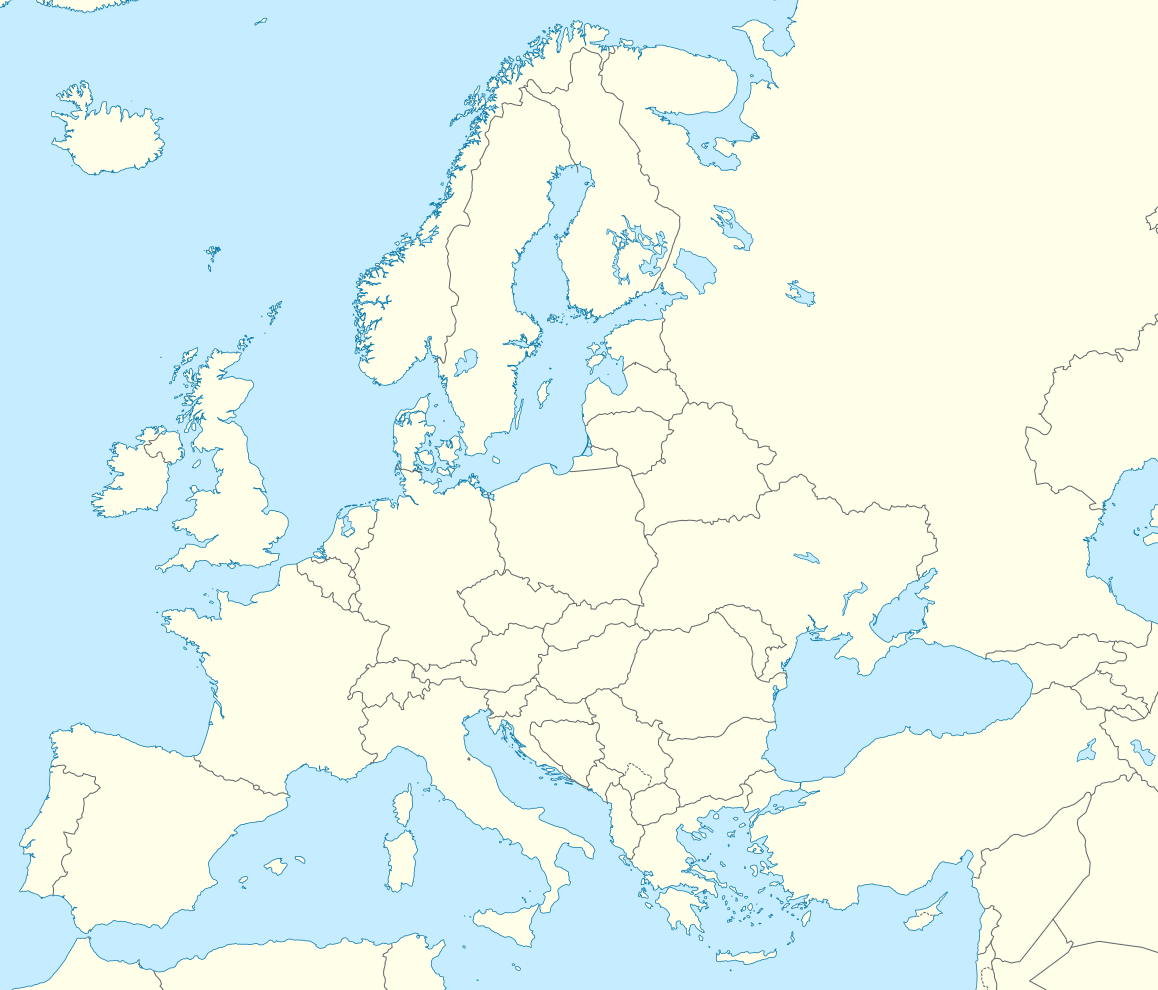 Budapest Alicante Athens Amsterdam Basel/Mulhouse Barcelona Bari Bergamo Berlin-TXL Berlin-SXF Billund Bristol Brussels Burgas Charleroi Bucharest Rome-Fiumicino Corfu Copenhagen Dortmund Dublin East-Midlands Eindhoven Edinburgh Frankfurt Gothenburg-City Hamburg Helsinki Heraklion Istanbul-Atatürk Istanbul-Sabiha Gökcen Kiev-Zhulyany Larnaca Lisbon Luton Stansted Heathrow LONDON Gatwick Leeds Madrid Málaga Malmö Manchester Milan-Malpensa Moscow-Sheremetyevo Moscow-Vnukovo Munich Minsk Naples Palma de Mallorca Paris-Orly Paris-Beauvais Oslo-Gardermoen Pisa Prague Rhodes Riga Rome-Ciampino Rotterdam Stockholm-Arlanda Stockholm-Skavsta Stuttgart St. Petersburg Tel Aviv Vienna Warsaw-Chopin Tampere Tirgu Mures Thessaloniki Venice-Treviso Zakynthos Hahn Paris-CDG Malta Catania Belgrade Geneva Zürich Cologne-Bonn Düsseldorf Europe destinations from Budapest International Airport; red: all-year round destinations, blue: seasonal destinations, yellow: future destinations, grey:terminated destinations, green: cargo destinations, brown: charter destinations |
| Asia destinations map |
|---|
 Taipei Beijing Hongkong Moscow Tel Aviv Doha Dubai Istanbul Almaty Baku Kutaisi Antalya Bangkok Pyongyang Karachi Astana Tokyo–Narita Phuket International destinations from Budapest International Airport ; red: all-year round destinations, blue: seasonal destinations, yellow: future destinations, grey:terminated, green: cargo destinations, brown: charter destinations |
| North America destinations map |
|---|
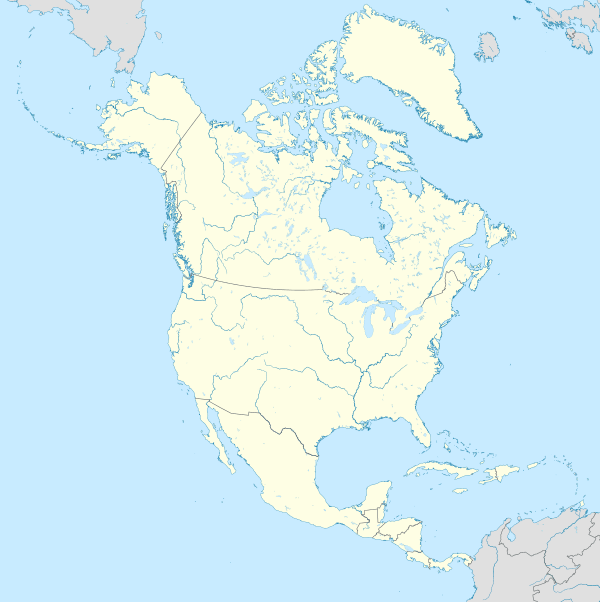 Toronto Montreal New York Chicago Newark International destinations from Budapest International Airport; red: all-year round destinations, blue: seasonal destinations, yellow: future destinations, grey:terminated, green: cargo destinations, brown: charter destinations |
Statistics
Annual passenger numbers
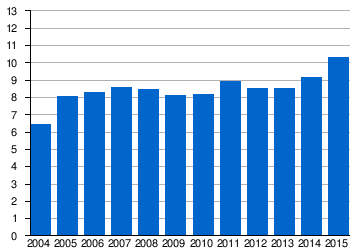 |
| Updated: 23 September 2016. |
| Passengers handled[lower-alpha 1] | Passenger % Change | |||
|---|---|---|---|---|
| 2004 | 6,456,983 | n/a | ||
| 2005 | 8,031,028 | 24.38% | ||
| 2006 | 8,266,677 | 2.93% | ||
| 2007 | 8,597,137 | 4.00% | ||
| 2008 | 8,443,053 | -1.79% | ||
| 2009 | 8,095,367 | -4.12% | ||
| 2010 | 8,190,089 | 1.17% | ||
| 2011 | 8,920,653 | 8.92% | ||
| 2012 | 8,504,020 | -4.67% | ||
| 2013 | 8,520,880 | 0.20% | ||
| 2014 | 9,155,961 | 7.45% | ||
| 2015 | 10,298,963 | 12.48% | ||
| 2016 | ||||
| Source: KSH[51] | ||||
Top destinations
| Rank | Airport | Passengers handled |
|---|---|---|
| 1 | London-Luton | 472,830 |
| 2 | Paris-Charles de Gaulle | 423,005 |
| 3 | Frankfurt | 421,144 |
| 4 | London-Stansted | 368,605 |
| 5 | Amsterdam | 329,131 |
| 6 | Munich | 323,262 |
| 7 | Brussels-Charleroi | 308,233 |
| 8 | London-Heathrow | 291,955 |
| 9 | Tel Aviv-Ben Gurion | 272,474 |
| 10 | Rome-Fiumicino | 239,016 |
| 11 | Istanbul-Atatürk | 229,092 |
| 12 | Barcelona | 210,114 |
| 13 | Madrid | 202,089 |
| 14 | Helsinki | 199,655 |
| 15 | Eindhoven | 196,724 |
| 16 | Warsaw-Chopin | 196,590 |
| 17 | Dublin | 195,597 |
| 18 | Milan-Malpensa | 194,793 |
| 19 | Zurich | 186,079 |
| 20 | London-Gatwick | 185,653 |
| 21 | Brussels-National | 183,533 |
Annual traffic
| Month | Passengers[52] | Change (2015-2016) | Passengers Cumulatively |
|---|---|---|---|
| January | 701,859 | 701,859 | |
| February | 683,831 | 1,385,690 | |
| March | 843,703 | 2,229,393 | |
| April | 926,790 | 3,156,183 | |
| May | 1,016,068 | 4,172,251 | |
| June | 1,053,257 | 5,225,508 | |
Other facilities
- Wizz Air has its head office in Building 221.[53] Wizz Air signed the lease agreement in October 2010 and moved there in June 2011 with 150 employees. The airline occupies over 2,000 square metres (22,000 sq ft) of space in an office building refurbished after the airline's arrival. The facility, with open plan offices, houses about 150 employees.[54] In addition, Farnair Hungary has its head office on the airport property.[55]
- Malév Hungarian Airlines signed a lease agreement with the airport in the spring of 2011, agreeing to relocate its headquarters to the airport grounds by the summer of 2012.[54][56] Due to the collapse of the airline, in February 2012 the plans to move to Ferenc Liszt were cancelled.
Ground transportation
Car
The airport is accessible by the Üllői road. Taxis are available from the taxi stand, however only one taxi company (Főtaxi) is authorised to use the airport cab stands. Additionally nearly all major rental companies operate at Ferihegy.[57]
Rail
Hungarian State Railways runs suburban and long-distance services between (the now closed) Terminal 1 and Nyugati Railway Station in Budapest city centre through Kőbánya-Kispest. The trip takes approximately 25 minutes. From Terminal 2 passengers need to take bus 200E to Ferihegy vasútállomás (Ferihegy railway station).
Public transport
During daytime, a bus connects with railway and the Metro Line 3 terminus at Kőbánya-Kispest.
During nighttime (23:00 to 04:00) the Nightbus connects with the 950 Nightbus stop at Bajcsy-Zsilinszky út. The 950 bus travels to Rákospalota via the City Center (Deák Ferenc tér) and Nyugati railway station.
Mini buses and shuttles
Several companies operate airport shuttles taking passengers to any destination in the city. Other shuttles and coach services exist to outlying towns in Hungary, Romania, Slovakia and Serbia.
See also
Notes
- ↑ Number of passengers including domestic, international and transit
References
- ↑ "Owners of Budapest Airport Zrt.(Ltd.)". © BUDAPEST AIRPORT. 2014-12-08. Retrieved 2014-12-08.
- ↑ GENERAL TERMS AND CONDITIONS OF ADVERTISING SERVICES PROVIDED BY BUDAPEST AIRPORT ZRT." (Archive) Budapest Airport. Retrieved on 25 February 2012.
- ↑ "ACI EUROPE Airport Traffic Report. December, Q4 and Full Year 2015" (PDF). Retrieved 28 August 2016.
- ↑ "Hungary AIP (final, November 12, 2015)". Retrieved 28 August 2016.
- ↑ "Cargo City construction at Budapest Airport." Budapest Ferenc Liszt International Airport. Retrieved on 4 February 2012.
- ↑ Budapest Airport. "Press release of Malév Zrt.". Retrieved 3 June 2015.
- ↑ "Hungarian airline Malev collapses." BBC. 3 February 2012. Retrieved on 3 February 2012.
- ↑ Dunai, Marton and Gergely Szakacs. "Rivals swoop in as Hungary's Malev stops flying." Reuters. Friday 3 February 2012.
- ↑ "PORTFOLIO.HU - Online Financial Journal". Retrieved 3 June 2015.
- ↑ Kirsten Grieshaber (29 September 2004). "World Briefing – Europe: Germany: Sentencing In 1991 Attack On Jews". The New York Times. Retrieved 3 January 2009.
- ↑ "HOCHTIEF AirPort Consortium takes over Budapest Airport". Budapest Airport website.
- ↑ "Budapest airport security status downgraded: Civil aviation". Retrieved 3 June 2015.
- ↑ "Budapest Business Journal". Retrieved 3 June 2015.
- ↑ Budapest Airport. "New shops opening one after the other". Retrieved 3 June 2015.
- ↑ Eddy, Kester. "Ryanair vs Budapest: playing dirty?" Financial Times. 7 February 2012. Retrieved on 9 February 2012.
- ↑ Simon, Zoltan. "Hungary Seeks Budapest Airport Compromise to Protect Budget." BusinessWeek. 9 February 2012. Retrieved on 9 February 2012.
- ↑
- "Hainan Airlines arrête son Pékin – Budapest." Air Journal. 14 February 2012. Retrieved on 30 August 2012.
- ↑ "Felfüggesztik a Peking-Budapest közvetlen légi járatot." China Radio International. 24 February 2012. Retrieved on 31 August 2012.
- ↑ "Partner airlines." Malév. 3 January 2011. Retrieved on 31 August 2012.
- ↑ "Budapest Airport stake sold to Canadian pension fund manager". Budapest Business Journal.
- ↑ "History - AviAlliance". AviAlliance corporate website.
- ↑ "Ownership of the Budapest Airport". Budapest Airport Corporate Website.
- ↑ http://www.bud.hu/english/business-and-partners/property
- ↑ Budapest Airport. "DHL moves to Budapest Airport Business Park". Retrieved 3 June 2015.
- ↑ Budapest Airport. "DHL moves to Budapest Airport Business Park". Retrieved 3 June 2015.
- ↑ "Turizmus.com".
- ↑ Budapest Airport. "Budapest Airport is prepared for Schengen accession - as of 30 March, Terminal 2A handles Schengen and Terminal 2B non-Schengen traffic". Retrieved 3 June 2015.
- ↑ Budapest Airport. "Terminal 1 renovation receives construction industry award for excellence". Retrieved 3 June 2015.
- ↑ d'artagnan bvba. "Europa Nostra". Retrieved 3 June 2015.
- ↑ "By train". Retrieved 3 June 2015.
- ↑ "Elérhetőségek." Transportation Safety Bureau. Retrieved on 20 February 2012. "H-1185 Budapest-Liszt Ferenc Nemzetközi Repülőtér 1, A-porta H-1675 Budapest, Pf.: 62"
- ↑ "Accessibility, customer service Directorate for Air Transport Archived 1 April 2011 at the Wayback Machine.." National Transport Authority. Retrieved on 20 February 2012. "Addresse: [sic] Budapest, Ferihegy I. Building 13. Accessibility: Ferihegy I. Gate.’A’ "
- ↑ Home page. Civil Aviation Safety Bureau of Hungary. 4 June 2004. Retrieved on 20 February 2012. "Gate A, Building 13 Budapest-Ferihegy 1, H-1185 H-1675 Budapest-Ferihegy, P.O.B. 62" – Hungarian address: "H-1185 Budapest-Ferihegy 1, A-porta 13-as faház H-1675 Budapest-Ferihegy, Pf.: 62"
- ↑ "Elérhetőségünk." Civil Aviation Authority. 1 March 2005. Retrieved on 20 February 2012. "Cím: Budapest, Ferihegy I., 13-as épület. Megközelíthető: Ferihegy I. "A" porta Levélcím: 1675 Budapest, PF 41."
- ↑ Home page. ABC Air Hungary Ltd. Retrieved on 19 February 2012. "ABC Air Hungary Ltd. Budapest Ferihegy Airport 1."
- ↑ http://www.emeraldmedia.co.uk/5/news/469/first-mastercard-lounge-in-europe-inaugurated-at-budapest-airport/
- ↑ http://www.sofia-airport.bg/%D0%BF%D1%8A%D1%82%D0%BD%D0%B8%D1%86%D0%B8/%D0%BF%D0%BE%D0%BB%D0%B5%D1%82%D0%BD%D0%B0-%D0%B8%D0%BD%D1%84%D0%BE%D1%80%D0%BC%D0%B0%D1%86%D0%B8%D1%8F/%D1%82%D1%8A%D1%80%D1%81%D0%B5%D0%BD%D0%B5-%D0%BD%D0%B0-%D0%BF%D0%BE%D0%BB%D0%B5%D1%82
- ↑ http://airlineroute.net/2015/11/26/u2-bodlys-s16/
- ↑ "Ryanair Announces 3 Additional New Athens Routes To Budapest, Bratislava & Santorini". corporate.ryanair.com.
- ↑ "Archived copy". Archived from the original on 7 July 2015. Retrieved 2015-07-08.
- ↑ http://airlineroute.net/2015/10/15/fr-cfu-s16/
- ↑ "Ryanair cans Tampere winter routes". Yle Uutiset. Retrieved 3 June 2015.
- ↑ "WizzAir to Begin Birmingham Service from Sep 2015". Airlineroute.net. 26 June 2015. Retrieved 26 June 2015.
- 1 2 http://bbj.hu/business/wizz-air-announces-two-new-routes_115202
- ↑ http://www.quicosenza.it/news/in-evidenza/109148-aeroporto-lameiza-aprile-si-volera-budapest-ciobn
- ↑ "Wizz Air announce flights to Liverpool".
- ↑ https://wizzair.com/en-GB/about_us/news/wizzen399
- ↑ "WIZZ AIR ANNOUNCES NEW SERVICES FROM BUDAPEST TO HURGHADA AND ALGHERO". Wizz Air. 15 December 2014.
- ↑ L, J (16 March 2015). "Air China Adds Minsk / Budapest Service from May 2015". Airline Route. Retrieved 16 March 2015.
- ↑ https://www.flightradar24.com/data/aircraft/ok-wdc
- ↑ "Repülőterek forgalmi adatai (2004-2015)" (in Hungarian). KSH. Retrieved 2016-04-15.
- ↑ Anna.aero database
- ↑ "Company overview Archived 12 March 2009 at the Wayback Machine.." Wizz Air. Retrieved on 11 December 2011. "Wizz Air Hungary Airlines Ltd. BUD International Airport Building 221 H-1185 Budapest"
- 1 2 "Property development." (Archive) Budapest Liszt Ferenc International Airport. Retrieved on 11 December 2011.
- ↑ "Our Offices." Farnair Europe. Retrieved on 19 February 2012. "H-1185 Budapest Liszt Ferenc ROK 17. Hungary"
- ↑ "MALÉV HEADQUARTERS MOVES BACK TO BUDAPEST AIRPORT." Malév Hungarian Airlines. 20 April 2011. Retrieved on 4 February 2012.
- ↑ https://www.sixt.com/car-rental/hungary/budapest/budapest-airport-terminal-2
External links
![]() Media related to Budapest Liszt Ferenc International Airport at Wikimedia Commons
Media related to Budapest Liszt Ferenc International Airport at Wikimedia Commons
- Official website
- Current weather for LHBP at NOAA/NWS
- Accident history for BUD at Aviation Safety Network